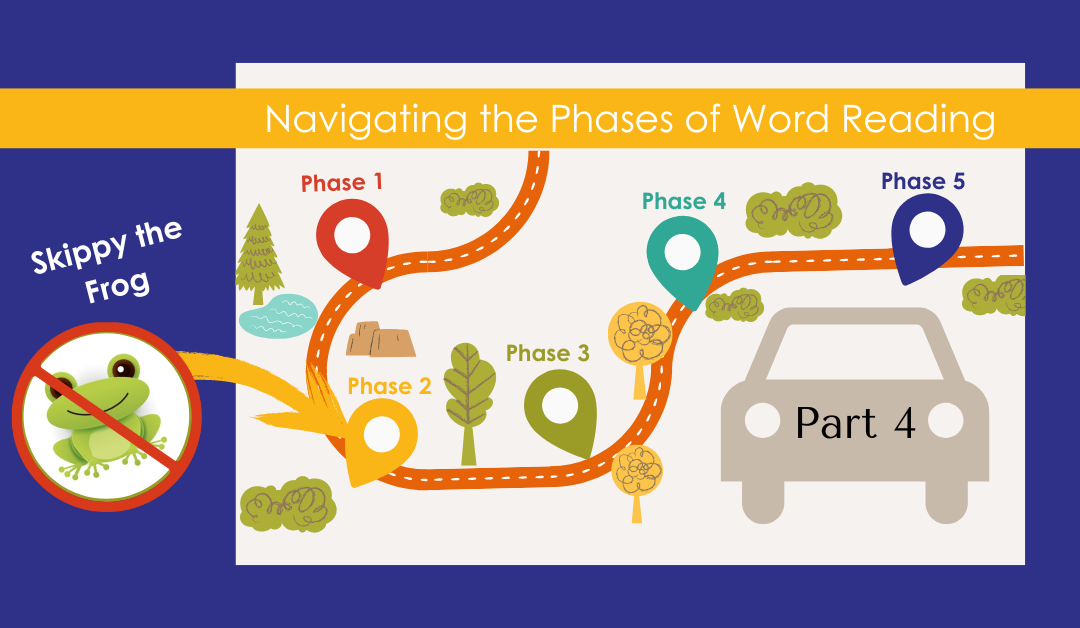This is our fourth installment in a 6-part series about how practices for supporting readers when they are stuck on a word can either help them find their way or potentially set up roadblocks in the future. So if you are wondering, “How can I help my students learn to find their way through words and arrive at meaningful reading?” then you are in the right place.
First, let’s bring you up to speed on this series so far:
- In the first post, we used the metaphor of reading a paper map (like in the “old” days) to explain Ehri’s Phases of Word Reading.
- In the second post, we used Ehri’s phases and the map-reading metaphor to consider the Beanie Baby strategy, Eagle Eye, and the hazards of prompting students with “Look at the picture” when they are stuck on a word.
- In the third post, we used the same phases and map metaphor to explore problems with Lips the Fish and prompting students to simply “Get your mouth ready” when they encounter a word they don’t know.
Today, let’s consider Skippy the Frog, once again thinking about Ehri’s Phases of Word Reading.
Perhaps you aren’t familiar with Skippy the Frog. Even so, you have probably used this strategy with students. The directions for the Skippy the Frog strategy are typically something like this:
Skip over the word.
Read the rest of the sentence.
Come back and see if you can fill in the word.
These directions prompt the reader to move past the word in order to gather more contextual information and then to come back to the word to see what they can use to figure it out. And this round-about method of arriving at a word via a detour through the context can seem like a great idea because it often works, especially with very simple texts!
Let’s look at an example. Consider the following sequence of events when a child is attempting to read the following sentence:
The red all over his face came from the ketchup on the hotdog.
- The child gets stuck on the word ketchup.
- We prompt the reader to “Skip the word and read on.”
- The child reads the rest of the sentence.
- The child has a lightbulb moment about what someone might get on their face when eating a hotdog.
- The child is able to easily go back and fill in the word “ketchup” without ever having to think about each of its sound-spellings in order.
Having read the previous posts, you might be asking, “So, if we’re prompting students to skip the word entirely, then are we nudging them back to the pre-alphabetic phase? After all, they are skipping over all the print in the word.
Great question! We really had to think about this one, too.
Remember, in the pre-alphabetic phase, children have the misguided idea that the pictures (which are part of the context) are the key to word reading. In the partial alphabetic phase, however, readers have begun to accumulate some helpful alphabetic knowledge, but are still operating on the misguided idea that reading can happen by still relying largely on context and only using “some” of the print. But, in the full alphabetic phase, readers grasp the alphabetic principle and understand that every single bit of print on the page–all of it!–must be considered in order to read (vs. figure out/guess/infer/predict) words.
What’s important to understand in the Skippy the Frog conversation–and in some of our previous conversations on this topic–is that it is possible for readers to be operating mostly in the full-alphabetic phase but for our prompts to actually cause them to revert back to the earlier, less skilled phase of pre- or partial alphabetics! And if we do this enough, the less mature practice can become habituated, taking the development of more mature reading off course.
Essentially, the “Skip over it” prompt gives children a mixed message about the importance of the alphabetic code and the way that sounds and their spellings align. It says, “Don’t worry about all of the print. You can probably figure the word out a different way.”
And although last week’s “Get your mouth ready” prompt is more common with emergent readers, “Skip over it” is widespread even with older readers. Ironically, as text complexity increases into upper elementary and middle school, teachers often use the skip-over-it prompt more and more as a means of compensating for the accumulating gaps in older students’ orthographic knowledge. Many students have been relying on strategies like these–shortcuts, really–that take them away from the print altogether and therefore minimize their opportunities for the very orthographic learning that drives reading in the first place.
So, let’s consider another example. Read the following sentence and try to fill in the “skipped word” with a plausible option.
She didn’t have enough _________ to see it through.
How did you do? We’re guessing not very well. You simply didn’t have enough information. So, how about if we let you look at the first couple of letters in the word?
She didn’t have enough co_________ to see it through.
Was that helpful? Do you know the word now? Would courage make sense? How about cooperation? Or confidence? Or maybe compassion? They all seem plausible. But what about cocoa or coal or coastline or cobblestones? These words could all work, too.
Even with a plausible possibility in mind, the only way to really know for sure if you have the actual word is to use all of the print, moving from left to right, pulling spellings and sounds together as you go. And when you do, you know for sure what the word is.
She didn’t have enough coffee to see it through.
Of course, for you, as a proficient reader, the word coffee has become one of tens of thousands of words that you recognize instantly and automatically. But that is only because you’ve done the work. You’ve put in the orthographic learning time. You’ve decoded the word, probably a number of times, and then you eventually did the brain work of gluing the sounds and spellings together through orthographic mapping.
Not only that, but you know the meaning of the word. This is what Kari might say if Jan doesn’t make a writing deadline– ”She didn’t have enough coffee to see it through!” So you really know the word–what it means and how to read it and write it automatically.
But you could never have come to this point automaticity with the word coffee if you had always gone around it with Skippy the Frog or Lips the Fish or Eagle Eye.
In our next post, we tackle another prompt that can actually delay fluent reading–the ”Look for a part you know” prompt.
Until then, let’s encourage kids to do a lot less skipping over the words on the page and a lot more working through them sound-by-sound, putting in the time in the full-alphabetic phase so that they are set up for the consolidated and automatic phases down the road.
❤️ Jan and Kari
P.S. Wondering what to use instead of word skipping?
You guessed it! Use a prompt that directs children to use the print, drawing on all they know about sound-spellings. Here are some of our favorites:
“Sound it out.”
“Look all the way across the word. Make the sounds.”
“Keep your eyes on the word. Put the sounds together.”
Then, only after students have used all of the print–sound-by-sound from left-to-right–to come up with what they think is the word, do we follow up with prompts like, “Did that make sense?” or “Does that sound right?” This keeps decoding as the strategy of first resort, and context and meaning as ways to confirm decoding attempts.
If you want to learn more about this important topic, it is the primary focus of Shift 5 in our book – Shifting the Balance: 6 Ways to Bring the Science of Reading into the Balanced Literacy Classroom – and in our online class.
References
Ehri, Linnea C. 1995. “Phases of Development in Learning to Read Words by Sight.” Journal of Research in Reading Research 18 (2): 116-125.
Ehri, Linnea C. 2005a. “Learning to Read Words: Theory, Findings, and Issues.” Scientific Studies of Reading, 9 (2): 167–188. doi: 10.1207/s1532799xssr0902_4
Ehri, Linnea C. 2005b. “Development of Sight Word Reading: Phases and Findings.” In M. J. Snowling and C. Hume (Eds.), The Science of Reading: A Handbook (pp. 135–154). Oxford, UK: Blackwell.
Ehri, Linnea C. 2017. “Orthographic Mapping and Literacy Development Revisited.” In Theories of Reading Development, ed. K. Cain, D. L. Compton, and R. K. Parrila (pp. 169-190). Amsterdam, The Netherlands: John Bejamins, doi: 10.1075/swll.15.08ehr.
Explore the whole blog series:
Showing Young Readers How to Navigate the Phases of Word Reading
Part 1: A Journey Through Ehri’s Phases
Part 2: Why Looking at the Pictures Isn’t as Helpful as We Thought
Part 3: Why Looking at the First Letter of the Word Isn’t Enough
Part 4: Problems With Skipping Words
Part 5: The Downsides of Asking Children to Search for Chunks in Words
Part 6: The Power of Teaching Students to Blend Words
BONUS: The Power of Teaching Readers to Try Alternate Sounds



Recent Comments